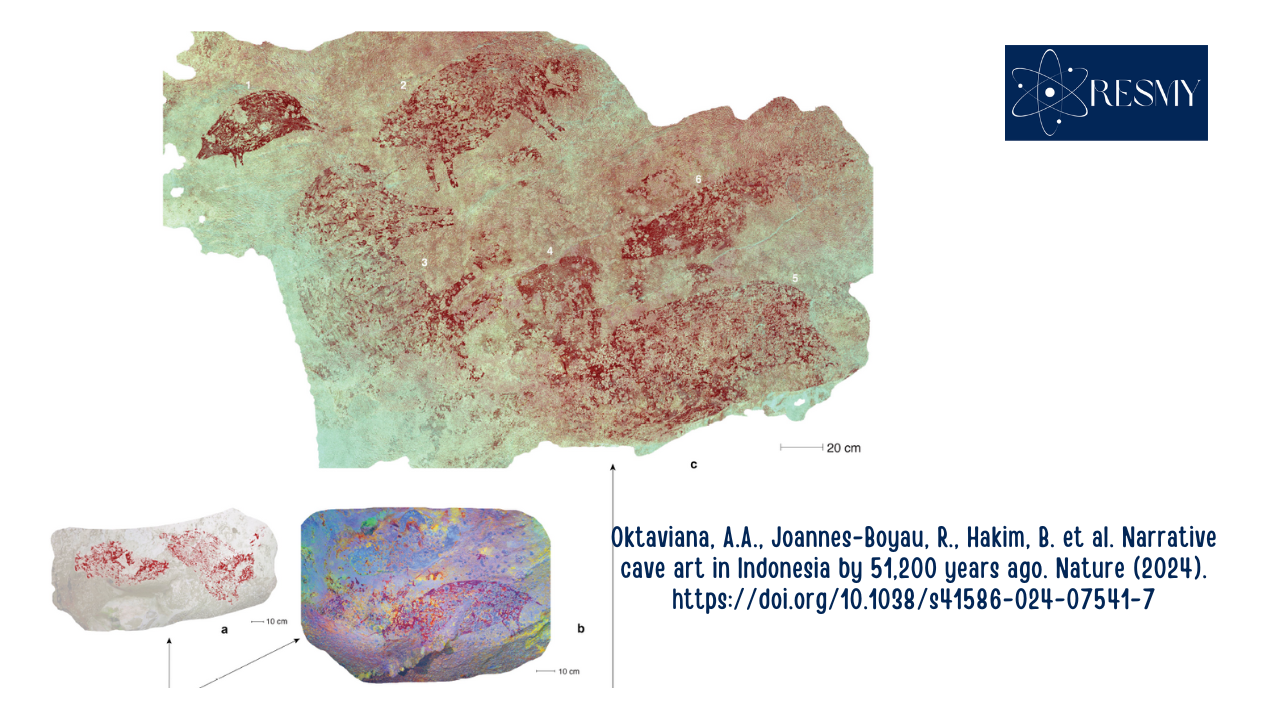In a groundbreaking discovery that reshapes our understanding of early human artistic expression, researchers have uncovered narrative cave art in Indonesia dating back over 51,000 years. This makes it the oldest known example of representational art and visual storytelling. The findings, published in Nature, not only push back the timeline of human creativity but also highlight the sophisticated techniques early humans used to depict their world.
The Discovery and Dating Technique
The Indonesian island of Sulawesi has long been known for its ancient rock art, but recent advancements in dating methods have provided new insights into just how old these artworks are. Previous studies using solution uranium-series (U-series) dating placed some of the art at around 43,900 years old. However, a novel laser-ablation U-series imaging technique has revealed that the actual ages are significantly older.
The laser-ablation U-series method, which offers enhanced spatial accuracy, has re-dated a hunting scene at Leang Bulu’ Sipong 4 to a minimum of 50.2 thousand years ago. Additionally, a newly described cave art scene at Leang Karampuang has been assigned a minimum age of 53.5 thousand years. This latter piece, which includes human-like figures interacting with a pig, is now the earliest known example of narrative art.
Significance of the Findings
These findings are crucial for several reasons. Firstly, they establish that figurative portrayals and visual storytelling have a deeper history in human culture than previously recognized. The art at Leang Karampuang, painted at least 51,200 years ago, showcases the early human ability to create complex scenes and convey stories through imagery.
The implications extend beyond just the timeline of art. These artworks provide valuable insights into the cognitive and cultural development of early humans. The scenes depict not only animals but also interactions between human-like figures and animals, suggesting a sophisticated level of symbolic thinking and perhaps even aspects of mythology or spiritual beliefs.
The Cave Art Scenes
The cave art at Leang Bulu’ Sipong 4 features a 4.5-meter-wide panel on the rear wall with several figurative paintings. These include human-like figures equipped with what appear to be spears or ropes, interacting with Sulawesi warty pigs and dwarf bovids known as anoas. Some figures are depicted with attributes that could be construed as non-human, blending the realms of human and animal in a manner reminiscent of mythological or shamanistic traditions.
At Leang Karampuang, the narrative scene is equally compelling, featuring anthropomorphic figures and a pig. This scene’s early date emphasizes the long-standing tradition of visual storytelling and its significance in early human societies.
Methodological Advances
The laser-ablation U-series dating technique represents a significant advancement over traditional methods. By focusing a laser on a polished cross-section of the calcite deposits covering the rock art, researchers can achieve greater precision and avoid some of the pitfalls of earlier methods. This technique allows for the analysis of the oldest calcite deposits closest to the pigment layer, providing more accurate minimum ages for the art.
This method also addresses the complex internal morphologies of coralloid speleothems (cave popcorn) often associated with rock art. These structures can include a mix of older material and younger infill, complicating age estimates. The laser-ablation approach maps the U-series isotopes across the surface areas of sample cross-sections, revealing the detailed growth history and allowing analysts to avoid areas affected by diagenesis.
Implications for Human History
The revelation that humans were creating complex, figurative art over 51,000 years ago in Indonesia adds a new dimension to our understanding of early human migration and cultural development. It suggests that symbolic thinking and the ability to create and interpret visual narratives were well-established much earlier than previously thought.
This discovery also prompts a reevaluation of other ancient artworks worldwide. It raises the possibility that other early human populations, such as those in Africa and Europe, may have developed similar artistic traditions contemporaneously, or even earlier, than those in Indonesia.
Conclusion
The narrative cave art discovered in Sulawesi, Indonesia, dating back over 51,000 years, represents a monumental milestone in the history of human creativity. This art not only pushes back the timeline of representational art but also provides profound insights into the cognitive and cultural capabilities of early humans. As dating techniques continue to advance, we can expect further revelations that will deepen our understanding of the origins and development of human artistic expression.
Other Topics: Medicine and Health Science, Natural Science, Agricultural Science, Engineering & Technology, Social Sciences & Humanities

